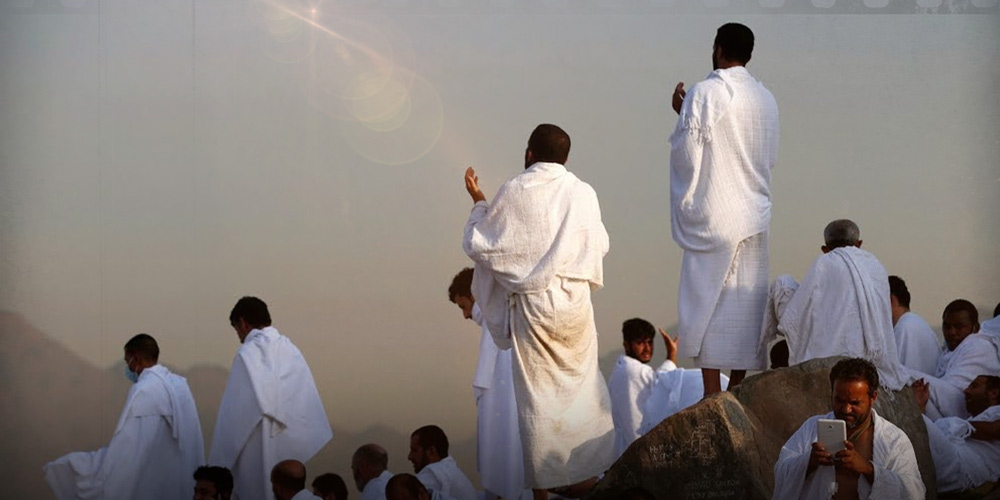Hajj rituals

Table of contents
Hajj rituals are performed during a specific period of the Hijri year, unlike Umrah, which can be performed at any time during the year, Hajj is one of the five pillars of Islam.
Information about Hajj
The Messenger of God, may God’s blessings and peace be upon him, said, “Islam has been built on five [pillars]: testifying that there is no deity worthy of worship except Allah and that Muhammad is the Messenger of Allah, establishing the salah (prayer), paying the zakat (obligatory charity), making the Hajj (pilgrimage) to the House, and fasting in Ramadhan”, the Messenger of God, may God’s blessings and peace be upon him, had spoken the truth, which means that Hajj is an obligation imposed by God Almighty on every sane, adult and able Muslim, the word able includes physical ability and material ability that enables a Muslim to perform the obligation without any external or health pressures.
Hajj is mentioned in several verses of the Holy Qur’an, in addition to a complete Qur’anic surah called “Surah Al-Hajj”, verse “27” (And announce to mankind the Pilgrimage; they shall come up (hurriedly) to you on foot and upon every slender (conveyance); they shall definitely come up from every deep ravine), the interpretation of the verse is that God Almighty commanded Ibrahim, peace be upon him (Khalilullah), to call people to Hajj, and told him that if you called them, they would come walking and riding, and God increased the reward of those who go on foot due to the double effort that they make and their perseverance to perform the Hajj, seeking the pleasure and forgiveness of God.
The performance of the Hajj rituals begins every year on the eighth day of the month of Dhu al-Hijjah according to the Hijri calendar, Hajj obligation is obligatory only once in a lifetime if a Muslim is able to do so, but it is not rejected that one repeats it, so it is considered voluntary on his part.
Types of Hajj
Hajj al-Ifrad: during which the Muslim intends Hajj only without Umrah.
Hajj al-Tamattu: It is known that the months of Hajj according to the Hijri calendar are (Shawwal, Dhul-Qi’dah, and the first eight days of Dhul-Hijjah) during which the Muslim intends to perform Umrah only, and performs it in full with its rituals, then breaks his Ihram for Umrah, and gets back to his normal life, on the eighth day of Dhul-Hijjah, the Muslim intends performing Hajj from where he is located, enters the state of Ihram and begins to perform the rituals of Hajj.
Hajj-al-Qiran: during which the pilgrim intends to perform Hajj and Umrah together.
Hajj rituals
Ihram: is the intention to perform Hajj, ihram is done in the Miqats set by the Messenger Muhammad, may God’s blessings and peace be upon him, determined for Hajj and Umrah, and they are:
Miqat Dhu al-Hulayfah (Abyar ‘Ali): the Miqat for those who come from or pass through Medina.
The Miqat of al-Juhfa: is for those who come from or pass through Egypt, the Levant or Maghreb, the city of (Rabigh) now replaces it.
As Sail Al Kabeer (Qarn Al-Manazil): It is the Miqat of the people of Najd in the Kingdom of Saudi Arabia, or who may pass through it.
Miqat Yalamlam: the Miqat for those who come from or pass through Yemen.
Dhat Irq: This Miqat was set by the Caliph Umar bin Al-Khattab, it is the Miqat for the people of Iraq or for those who pass through it.
As for the people of Mecca, they can enter Ihram from their homes, from Al-Tan’im (one of the mosques in Mecca) or Al-Ja’rana.
As soon as the pilgrim arrives at the Miqat, he clips his nails and shaves pubic hair (recommended matters), then takes a bath like ghusl from impurity, performs ablution, and wears the Ihram garment, as for the woman, she can wear whatever she wants, provided that she follows the Islamic dress and removes the niqab and gloves, if any, while men wear an unstitched uniform and is called (izar and Rida) and they are white and clean, then performs the two rak’ahs of ihram, holds the intention and recites the Talbiyah. The wording of the Talbiyah differs between the three types of Hajj (Hajj al-Ifrad: “Labbaik Umrah”, Hajj al-Tamattu: “Labbaik Umrah” given that the pilgrim performs the rituals of Umrah first and then breaks his Ihram again to perform the Hajj, and Hajj-al-Qiran: “Labbaik Hajj and Umrah”, then the pilgrim leaves his Miqat, heading for Mecca.
Hajj al-Tamattu: the pilgrim performs the rituals of Umrah in full, then breaks his Ihram, waiting for the eighth day of Dhul-Hijjah, to enter into the state of ihram again to perform the rituals of Hajj.
Hajj-al-Qiran and al-Ifrad: The pilgrim performs the circumambulation of arrival, and remains in ihram until the day of al-Tarwiyah, on the eighth of Dhul-Hijjah
The Talbiyah is as follows: “Here I am [at your service] O God, here I am. Here I am [at your service]. You have no partners (other gods), here I am. To You alone is all praise and all excellence, and to You is all sovereignty. There is no partner to You.”
Heading to the Grand Mosque and Tawaf:
Upon arriving to Mecca, it is desirable to say (Oh God, this is Your sanctuary and security, so forbid my flesh and blood to be on fire, and protect me from Your punishment on the day Your servants are resurrected, and make me among the people of faith and obedience, O Lord of the worlds), and upon reaching the Sacred Mosque, the Takbir starts by saying (O God, increase this House in honor, glorification, prestige, and security, and increase those who perform Hajj or Umrah in it in honor, reverence and righteousness), and repeating the Talbiyah “Here I am [at your service] O God, here I am. Here I am [at your service]. You have no partners (other gods), here I am. To You alone is all praise and all excellence, and to You is all sovereignty. There is no partner to You”. The pilgrim enters the Sacred House, with his right foot, starting by saying (In the name of God, prayer and peace be upon the Messenger of Allah, O God, forgive my sins, and open Your doors of mercy before me), then the pilgrim starts the circumambulation from the corner where the Black Stone is located, with the house to the left of the pilgrim, and if possible, the pilgrim takes hold of the Black Stone with his right hand and kisses it, and if the pilgrim is not able to do so, it is enough for him to point with his right hand. If the pilgrim is able to perform the Tawaf of Arrival, he repeats in front of the Black Stone (In the name of Allah, Allah is the greatest) and jogs during the first three rounds, while walks slowly during the remaining four, and the supplication is made between the Black Stone and the Yemeni Corner “O Allah, our Lord! Give us that which is good in this life, that which is good in the Hereafter and save us from the torment of the Fire”. During the rounds, the pilgrim supplicates for what he wishes, then goes to the shrine of Ibrahim, peace be upon him, and performs two rak’ahs behind it or in any other place after reciting “Take the spot where Abraham stood as your place of prayer“ (verse 125 of Surah Al-Baqarah), during the first rak’ah the pilgrim recites Surah Al-Fatihah, followed by Surah Al-Kafirun, while in the second rak’ah, Surah Al-Fatihah is recited, followed by Surah Al-Ikhlas, the recitation of Surah Al-Kafirun and Surah Al-Ikhlas is not conditional but desirable, so the pilgrim can recite what is easy for him after Al-Fatihah in both rak’ahs, then drinks from Zamzam water.
Then the pilgrim proceeds to perform Sa’y between as-Safa and al-Marwa, with the beginning of the first round, the ascent of the Safa and the reception of the Kaaba, the pilgrim recites the tahlil and the takbeer three consecutive times, then repeats “There is no god but Allah, alone without partners. To Him belongs all dominion and praise, He is over all things powerful. There is no god but God alone. He fulfilled His promise, helped His servant, and defeated the parties alone”, for three times as well, and read verse 158 of Surah Al-Baqarah, “Surely the Safa and the Marwah are among the signs of Allah; so whoever makes a pilgrimage to the House or per-forms ‘umrah thereof, there is no blame on him to go round them both; and whoever on his own accord does good, then surely Allah is Grateful, All-knowing”, then, the pilgrim descends to Al-Marwah and jogs between the two green flags, and when he reaches Al-Marwah, he does the same rituals as those of Al-Safa, with the exception of the noble verse from Surah Al-Baqarah, until seven rounds are completed, the distance between Al-Safa to Al-Marwah is counted as one round, and the return from Al-Marwa to Al-Safa is another round.
Then the pilgrim shaves or shortens his head hair, and by performing these rituals, Umrah will have been completed for those who perform Hajj al-Qiran or al-Tamattu, the pilgrims of hajj al-Tamattu break their Ihram, and the pilgrims of Hajj al-Qiran remain in the state of Ihram until the eighth day of Dhu al-Hijjah.
Day of Tarwiyah
Al-Tarwiyah is the eighth day of Dhu al-Hijjah, during which the pilgrim of hajj al-Tamattu enters the state of Ihram, while the pilgrim who is performing Hajj-al-Qiran and al-Ifrad is still in the state of Ihram from the Miqat, on this day the pilgrims head to Mina and shorten Zuhr, Asr, Maghrib and Isha prayers without combining them. Staying overnight in Mina is not obligatory, but it is Sunnah, as the pilgrim can go directly to Arafah, and during the stay in Mina, the pilgrim recites the Talbiyah (Here I am [at your service] O God, here I am. Here I am [at your service]. You have no partners (other gods), here I am. To You alone is all praise and all excellence, and to You is all sovereignty. There is no partner to You), and supplicates for whatever he wishes.
Standing at Arafat
Standing at Arafat is in the day following the day of Tarwiyah, the ninth of Dhu al-Hijjah, it is the most important pillar of the rituals of Hajj, as the Messenger, may God’s blessings and peace be upon him, said, “Hajj is Arafa”. Standing at Arafah will be from the sunset of the ninth day until the morning of the next day (the Day of Sacrifice), which is the first day of Eid al-Adha, and the pilgrims combine and shorten Zuhr and Asr prayers in advance, then perform the Talbiyah, supplication and dhikr as the Messenger said (The best supplication is that of the Day of Arafah, and the best that anyone can say is what I and the Prophets before me have said: There is no God but Allah, alone, without a partner, to Him belongs the kingdom and to Him is praise, and He has power over all things).
Muzdalifah
Spending the night at Muzdalifah until dawn is obligatory, the pilgrim combines and shortens Maghrib and Isha prayers, and throws Jamrat al-Aqaba after picking up 7 pebbles from anywhere.
The tenth day of Dhu al-Hijjah
After picking up the seven pebbles, they are thrown at Jamrat al-Aqaba in succession, then the pilgrim slaughters the sacrifice, which is obligatory on the pilgrims of Hajj al-Tamattu and Hajj-al-Qiran, and desirable for the pilgrim of Hajj al-Ifrad, after that the pilgrim shaves or shortens his head hair.
Tawaf Al-Ifadah
The pilgrim returns to Mecca to perform Tawaf Al-Ifadah, and if he has broken his Ihram, he can circumambulate with his clothes.
Days of Tashreeq
These are the 11th, 12th, and 13th days of Dhu al-Hijjah, during which the stoning of Jamarat takes place. If the pilgrim wants to return to his home, he performs the farewell circumambulation, which consists of seven rounds, while it is permissible not to perform this circumambulation for menstruating or postpartum women.





